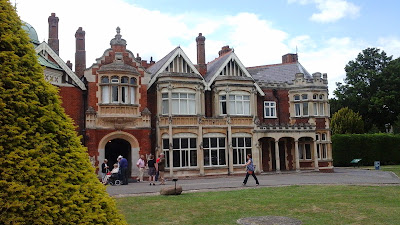This visit was another reason I applied for this program. I'm a fan of the program Bletchley Circle, and read The Secret Lives of Codebreakers for an assignment prior to coming to London, and have become fascinated with place. During World War II, Bletchley Park was the secret base for the U.K.'s Government Code and Cipher School. All of the work to decode enemy messages during the war took place on this site by an unlikely mix of people--from academics and university students, to debutantes, to military and intelligence personnel, to teenage messenger girls.
All of this activity took place with the greatest secrecy. It is difficult to imagine today how such a massive number of people (an estimated 9,000 to 10,000) were recruited, trained, and worked at Bletchley—and lived in the surrounding towns—without the secret getting out about the work that was going on there. With the exception of a slip of the tongue here and an attempt to impress a love interest there, most recruits did not breathe a word to their families or friends about the work they did during the war...for decades. People are still just learning now that Grandma cracked German or Japanese code during the War. No one in the neighboring towns, who were tasked with housing these workers, questioned what their tenants were up to. And even within the Park, work was compartmentalized so that, for example, a message would be translated in one hut and conveyed by phone to some other location in the Park. Not until years later, after the Park opened as a museum, did veterans realize that the place they had been phoning was the hut next door.
Image from: http://www.bletchleypark.org.uk/.
When we arrived, we went straight to the National Museum of Computing. According to the website, the museum has "the largest collection of functional historic computers in Europe." I thought of my friend Margie, who would have loved seeing all of the computer systems they have and watching them work. But it was way over my head. If I hadn't known anything about Bletchley before I came (and some of my classmates didn't), I wouldn't have known what our guide was talking about when he talked about Bombes and Collosi--two of the machines developed and used to break code during WWII. Beyond that, it was extremely technical and completely lost on me. I couldn't even follow along enough to bring back some cool tidbits for Margie. I did take a few pictures, so hopefully they'll make sense to her...
A rebuilt, working Collosus.
An EDSAC.
I don't remember what this is. But my classmate Kim got to operate it.
I was very surprised to see a quilt on one of the walls (the only quilt I've seen the whole trip). So, of course, I got a picture of that.
Our tour guide was friendly and witty and seemed tremendously knowledgeable about all the technology he showed us. I feel badly that I wasn't able to follow.
In the afternoon, we did a walking tour of the Park. It was surreal to be in this place that I'd read about and seen on my TV screen.
Sadly, we didn't get to go into the house or any of the huts where people worked. We did have time to pop our heads into the museum portion of the park. There I got to see a working replica of a Bombe. (All of the machines used during the war were destroyed, so they had to use plans and parts they found later to rebuild these machines--the Bombes and the Collosi--now in the Park.)
In this video, Jean Valentine, who served in the Women's Royal Naval Service and worked on the Bombes at Bletchley, talks about her experience.
The museum also had a whole display of Enigma machines. The Germans used these small machines during the war to encrypt all their messages. All of the efforts at Bletchley were aimed at cracking the encryption created by these small machines. They were considered uncrackable...until the people at Bletchley cracked them. It is thought that the work at Bletchley shortened the war by at least 2 years and possibly spared the Germans the atomic bomb.
This video demonstrates how the Enigma works:








No comments:
Post a Comment